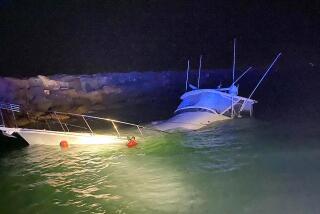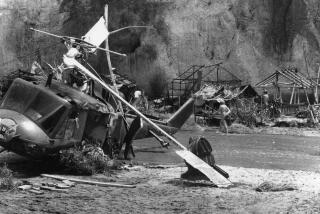Retrial Ordered in Case of Fatal ’84 Boat Crash
- Share via
Rejecting defense claims that another trial would be unfair, a Superior Court judge ruled Friday that Virl H. Earles must be retried for involuntary manslaughter in a 1984 boat crash that killed five people.
Although a jury deadlocked 9-3 in favor of acquittal last month in the case, Judge Jean Rheinheimer said in court Friday that retrials are not unprecedented in such circumstances. Without commenting directly on the merits of the prosecution’s case, she said the evidence did not merit “me interfering with that (a retrial).”
Rheinheimer rejected defense attorney Gary Pohlson’s request that she consider dismissing the charges “in the interest of justice.”
Earles was ordered to appear before Superior Judge Luis A. Cardenas for retrial on May 12.
During Friday’s hearing, Pohlson argued the case should be dropped because the first trial almost ended in acquittal, the crime was unintentional and Earles continually suffers feelings of guilt about his five dead friends.
Calls Retrial Justified
But Deputy Dist. Atty. John Conley argued that a retrial was justified because Earles’ conduct had left five people dead. Conley said also that Earles, unlike some suspects who are incarcerated only to be found not guilty later, has not had to stay in jail and suffer.
Only last week, Earles had shown up in court expecting prosecutors to seek dismissal of the charges. He expressed anger and disappointment upon learning that the district attorney’s office was seeking a retrial. “This is terrible,” Earles said last week. “Why do we have to go through this all over again.”
Earles was at the helm when his boat struck an 11-foot-wide concrete buoy head-on late at night, killing five of his eight passengers. Earles and three other survivors were seriously injured.
The group had been returning through Anaheim Bay from a boat ride to view the Queen Mary on Oct. 28, 1984. The buoy was along the west side of the bay, well out of the channel boaters are required to follow.
At his first trial, Earles claimed that improper navigational lights marking the entrance to the bay caused him to miss the channel and head straight toward the unlit buoy.
Prosecutors argued that Earles, by his own admission, was driving at least 30 m.p.h. inside the bay, which has a speed limit of 5 m.p.h.
More to Read
Sign up for Essential California
The most important California stories and recommendations in your inbox every morning.
You may occasionally receive promotional content from the Los Angeles Times.













